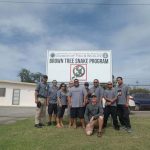Anti-snake program exceeds inspection goals in FY ’17
- The Brown Tree Snake Program is made up of nine staffers, with one canine trainer, four Saipan-based dog handlers, one on Tinian, and two on Rota. (Contributed Photo)
- A dog named Paulie inspects incoming cargo. (Contributed Photo)
The Brown Tree Snake Interdiction Program has exceeded its inspection performance for fiscal year 2017 on Saipan, Tinian, and Rota, according to Lands and Natural Resources Secretary Anthony Benavente.
“The CNMI Brown Tree Snake Interdiction team did amazing work in the past year and prevented the entry of [brown tree snakes] to the islands.
“I commend our program coordinator and K9 [canine] inspectors for their ongoing diligence to ensure that all vessels and cargo arriving at ports of entry on Saipan, Tinian, or Rota are clear and snake-free.
“Our program performance standards for inspections are to maintain a 90-percent canine inspection rate of Guam-based cargo arrivals, and maintain approximately 450 snake traps at all CNMI ports of entry and I am very pleased that the team has exceeded this and no brown tree snake have entered the CNMI,” Benavente said.
The program is made up of nine staffers, with one brown tree snake canine trainer, four canine handlers on Saipan, one on Tinian, and two on Rota. The program received no credible snake sightings within the fiscal year. Although calls on the snake hotline were received—three calls on Saipan and one on Rota—they were confirmed as brahminy blind snakes (Indotyphlops braminus), which are a non-injurious snake species known to be common in the CNMI.
Program coordinator Kevin Donmoyer said that Saipan exceeded the 90-percent inspection performance goal each month.
At the same time 2,307 out of 2,423 commercial flights were successfully inspected. Of those inspections, 84.5 percent used a canine team and 12.3 percent were visually inspected.
“In addition to the commercial flights, the CNMI also received military aircraft. During the reporting period, the program inspected 38 military aircraft on Saipan, which used the international airport to refuel, unload/on-load personnel, or offload cargo prior to heading to the Northern Islands.
“During a May exercise, some helicopters preferentially came to Saipan prior to Tinian, so they may receive a [brown tree snake] inspection. Saipan also received three military vessels, which unloaded vehicles and supplies for an exercise, and on Tinian, many aircraft landed as part of the COPE North and ARC-17 training exercises.
“Although all reported military flights were inspected, the program became aware of frequent Guam National Guard flights, which were not contacting Saipan operations prior to arrival. Once this hole in communication was identified in May, the commanding officers in Guam were notified and Saipan personnel are a part of the National Guard’s phone tree, ensuring we are alerted to their future arrivals,” Donmoyer said.
In terms of cargo entering the CNMI’s seaports, Donmoyer noted that the majority of the seaport activity occurs on Saipan, with a minimal amount on Rota and Tinian. On Saipan, 94 cargo inspections were reported and on Rota there has been an increase in private vessels transporting cargo from Guam. On average, brown tree snake staff on Rota expect four private vessel arrivals per week at the small-boat harbor on Rota, with three vessels with cargo on Tinian during the reporting period.
“We are happy to report that there have been no credible [brown tree snake] sightings reported. Our program has shown continued improvement over the year, but there is still more growth ahead. We look forward to improving our data collection of all islands and strengthen contact with all incoming vessels and we hope for even better outcomes as time progresses,” Donmoyer said.
Gov. Ralph DLG Torres emphasized that the program plays a key part in safeguarding the CNMI’s ecosystem and community.
“Invasive species significantly damage our local habitat and can have significant effects and disruption to the economy. Preventing the spread of [brown tree snakes] is a continual effort, and I recognize and commend the efforts of our [brown tree snake] team who’ve maintained and exceeded their program’s inspection performance. Again, we’ve been so fortunate to say that our Commonwealth is snake-free and that our bird population is thriving. DLNR’s perseverance has helped preserve our current bird habitat and ecosystem. As we continue work in containing and eradicating invasive species such as the coconut rhinoceros beetles on Rota, I maintain our commitment to providing the necessary resources to combat all invasive species as much as possible,” Torres said.
The last snake to be trapped outside of Guam was on the island of Rota in August 2014. The last brown tree snake found on an aircraft in the CNMI occurred in 2000 on the island of Saipan. (PR)





























